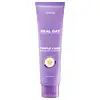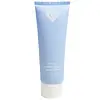What's inside
What's inside
 Key Ingredients
Key Ingredients

 Benefits
Benefits

 Concerns
Concerns

 Ingredients Side-by-side
Ingredients Side-by-side

Water
Skin ConditioningCocamidopropyl Betaine
CleansingGlycerin
HumectantAvena Sativa Kernel Meal
AbrasivePEG-150 Distearate
EmulsifyingSodium Lauroyl Methylaminopropionate
CleansingAcrylates Copolymer
Potassium Cocoyl Glycinate
Sodium Benzoate
MaskingAllantoin
Skin ConditioningPotassium Cocoate
EmulsifyingCitric Acid
BufferingPanthenol
Skin ConditioningPhenoxyethanol
PreservativeButylene Glycol
HumectantPotassium Hydroxide
BufferingEthylhexylglycerin
Skin ConditioningChamomilla Recutita Extract
Skin ConditioningPropylene Glycol
HumectantCeteareth-25
CleansingLaminaria Digitata Extract
Skin Protecting1,2-Hexanediol
Skin ConditioningCetyl Alcohol
EmollientHydrogenated Lecithin
EmulsifyingCholesterol
EmollientCeramide NP
Skin ConditioningBehenic Acid
CleansingCeramide Ns
Skin ConditioningCeramide EOP
Skin ConditioningCeramide AP
Skin ConditioningCeramide Eos
Skin ConditioningCetyl-Pg Hydroxyethyl Palmitamide
Skin ConditioningCeramide As
Skin ConditioningCaprooyl Phytosphingosine
Skin ConditioningCaprooyl Sphingosine
Skin ConditioningWater, Cocamidopropyl Betaine, Glycerin, Avena Sativa Kernel Meal, PEG-150 Distearate, Sodium Lauroyl Methylaminopropionate, Acrylates Copolymer, Potassium Cocoyl Glycinate, Sodium Benzoate, Allantoin, Potassium Cocoate, Citric Acid, Panthenol, Phenoxyethanol, Butylene Glycol, Potassium Hydroxide, Ethylhexylglycerin, Chamomilla Recutita Extract, Propylene Glycol, Ceteareth-25, Laminaria Digitata Extract, 1,2-Hexanediol, Cetyl Alcohol, Hydrogenated Lecithin, Cholesterol, Ceramide NP, Behenic Acid, Ceramide Ns, Ceramide EOP, Ceramide AP, Ceramide Eos, Cetyl-Pg Hydroxyethyl Palmitamide, Ceramide As, Caprooyl Phytosphingosine, Caprooyl Sphingosine
Water
Skin ConditioningGlycerin
HumectantPolysorbate 20
EmulsifyingCetyl Alcohol
EmollientCetearyl Alcohol
EmollientDisodium Cocoyl Glutamate
CleansingButylene Glycol
HumectantPEG-40 Hydrogenated Castor Oil
EmulsifyingPolyacrylamide
Cocamidopropyl Betaine
CleansingC13-14 Isoparaffin
EmollientC9-11 Pareth-6
EmulsifyingAvena Sativa Kernel Extract
AbrasiveAvena Sativa Kernel Flour
AbrasiveOryza Sativa Bran Extract
Skin ConditioningInositol
HumectantChamomilla Recutita Extract
Skin ConditioningHydroxypropyl Methylcellulose
Emulsion StabilisingDMDM Hydantoin
PreservativeSodium Hyaluronate
HumectantSodium Lactate
BufferingParfum
MaskingCitric Acid
BufferingBisabolol
MaskingWater, Glycerin, Polysorbate 20, Cetyl Alcohol, Cetearyl Alcohol, Disodium Cocoyl Glutamate, Butylene Glycol, PEG-40 Hydrogenated Castor Oil, Polyacrylamide, Cocamidopropyl Betaine, C13-14 Isoparaffin, C9-11 Pareth-6, Avena Sativa Kernel Extract, Avena Sativa Kernel Flour, Oryza Sativa Bran Extract, Inositol, Chamomilla Recutita Extract, Hydroxypropyl Methylcellulose, DMDM Hydantoin, Sodium Hyaluronate, Sodium Lactate, Parfum, Citric Acid, Bisabolol
 Reviews
Reviews

Ingredients Explained
These ingredients are found in both products.
Ingredients higher up in an ingredient list are typically present in a larger amount.
Butylene Glycol (or BG) is used within cosmetic products for a few different reasons:
Overall, Butylene Glycol is a safe and well-rounded ingredient that works well with other ingredients.
Though this ingredient works well with most skin types, some people with sensitive skin may experience a reaction such as allergic rashes, closed comedones, or itchiness.
Learn more about Butylene GlycolCetyl Alcohol is a fatty alcohol. Fatty Alcohols are most often used as an emollient or to thicken a product.
Its main roles are:
Though it has "alcohol" in the name, it is not related to denatured alcohol or ethyl alcohol.
The FDA allows products labeled "alcohol-free" to have fatty alcohols.
Learn more about Cetyl AlcoholThis ingredient comes from the Chamomile flower.
Chamomile is rich in antioxidants and has anti-inflammatory properties. Several compounds found in chamomile help with soothing, such as bisbolol.
Antioxidant components in chamomile help fight free-radical molecules. These unstable molecules may damage your skin cells. By stabilizing them, antioxidants may help reduce the signs of aging.
Ancient Greeks, Romans, and Egyptians used Chamomile to treat skin redness and dryness. Chamomile has also been used to help with stomach issues.
Learn more about Chamomilla Recutita ExtractCitric Acid is an alpha hydroxy acid (AHA) naturally found in citrus fruits like oranges, lemons, and limes.
Like other AHAs, citric acid can exfoliate skin by breaking down the bonds that hold dead skin cells together. This helps reveal smoother and brighter skin underneath.
However, this exfoliating effect only happens at high concentrations (20%) which can be hard to find in cosmetic products.
Due to this, citric acid is usually included in small amounts as a pH adjuster. This helps keep products slightly more acidic and compatible with skin's natural pH.
In skincare formulas, citric acid can:
While it can provide some skin benefits, research shows lactic acid and glycolic acid are generally more effective and less irritating exfoliants.
Most citric acid used in skincare today is made by fermenting sugars (usually from molasses). This synthetic version is identical to the natural citrus form but easier to stabilize and use in formulations.
Read more about some other popular AHA's here:
Learn more about Citric AcidCocamidopropyl Betaine is a fatty acid created by mixing similar compounds in coconut oil and dimethylaminopropylamine, a compound with two amino groups.
This ingredient is a surfactant and cleanser. It helps gather the dirt, pollutants, and other impurities in your skin to be washed away. It also helps thicken a product and make the texture more creamy.
Being created from coconut oil means Cocamidopropyl Betaine is hydrating for the skin.
While Cocamidopropyl Betaine was believed to be an allergen, a study from 2012 disproved this. It found two compounds in unpure Cocamidopropyl Betaine to be the irritants: aminoamide and 3-dimethylaminopropylamine. High-grade and pure Cocamidopropyl Betaine did not induce allergic reactions during this study.
Learn more about Cocamidopropyl BetaineGlycerin is already naturally found in your skin. It helps moisturize and protect your skin.
A study from 2016 found glycerin to be more effective as a humectant than AHAs and hyaluronic acid.
As a humectant, it helps the skin stay hydrated by pulling moisture to your skin. The low molecular weight of glycerin allows it to pull moisture into the deeper layers of your skin.
Hydrated skin improves your skin barrier; Your skin barrier helps protect against irritants and bacteria.
Glycerin has also been found to have antimicrobial and antiviral properties. Due to these properties, glycerin is often used in wound and burn treatments.
In cosmetics, glycerin is usually derived from plants such as soybean or palm. However, it can also be sourced from animals, such as tallow or animal fat.
This ingredient is organic, colorless, odorless, and non-toxic.
Glycerin is the name for this ingredient in American English. British English uses Glycerol/Glycerine.
Learn more about GlycerinWater. It's the most common cosmetic ingredient of all. You'll usually see it at the top of ingredient lists, meaning that it makes up the largest part of the product.
So why is it so popular? Water most often acts as a solvent - this means that it helps dissolve other ingredients into the formulation.
You'll also recognize water as that liquid we all need to stay alive. If you see this, drink a glass of water. Stay hydrated!
Learn more about Water